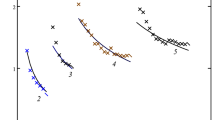Abstract
The valences of bonds can be predicted from the bonding network using (by analogy with electrical networks) Kirchhoff-like equations which lead to the definition of a new atomic property, the Valence Potential. The computer algorithm used in this prediction indicates that the electrons on any ion tend to be shared equally between all the bonds and that, despite appearances to the contrary, the rules of bonding around cations and anions are identical. These rules are the basis of a number of structure prediction and modelling techniques which make use of the correlation between bond valence and bond length. A three parameter equation is proposed to describe this relation for those bonds (e.g. H-O, Na-O, Tl-O) which occur with a wide range of lengths and for which, therefore, the usual two parameter equations are not adequate.
Similar content being viewed by others
References
Altermatt D, Brown ID (1987) A real space computer-based symmetry algebra. Acta Crystallogr A 43:125–130
Bergerhoff G, Hundt R, Sievers R, Brown ID (1983) The inorganic crystal structure database. J Chem Info 23:66–69
Brown ID (1976) On the geometry of O-H 0 hydrogen bonds. Acta Crystallogr A 32:224–231
Brown ID (1977) Predicting bond lengths in inorganic crystals. Acta Crystallogr B 33:1305–1310
Brown ID (1978) Bond Valences — A simple structural model for inorganic chemistry. Chem Soc Rev 7:359–376
Brown ID (1981) The bond valence method: an empirical approach to chemical structure and bonding, in O'Keefe M, Navrotsky A (eds) Structures and Bonding in Crystals II, Academic Press, New York, 1–30
Brown ID, Altermatt D (1985) Bond valence parameters obtained from a systematic analysis of the inorganic crystal structure database. Acta Crystallogr B 41:244–247
Cominiti R, Licher G, Piccaluga G, Pinna G (1978) Hydration waterexternal water intractions around Cr3+ ions. J Chem Phys 69:1–4
Garrett JD, Greedan JE, Faggiani R, Carbotte S, Brown ID (1982) Single crystal growth and structure determination of Ag16I12P2O7. J Solid State Chem 42:183–190
Hawthorne FC (1985) Towards a structural classification of minerals: The vi M iv T 2φ n minerals. Am Mineral 70:455–473
Mitchell KAR, Schlatter SA, Sodhi RNS (1986) Further analyses of surface bond lengths measured for chemisorption on metal surfaces. Can J Chem 64:1435–1439
Pauling L (1929) The principles determining the structure of complex ionic crystals. J Am Chem Soc 51:1010–1026
Villiger H (1969) DLS-Manual. Inst Krist Petr ETH, Zurich
Waltersson K (1978) A method based upon ‘bond strength’ calculations, for finding probable lithium sites in crystal structures. Acta Crystallogr A 34:901–905
Wenk HR, Raymond KN (1973) Four new structure refinements of olivine. Z Kristallogr 137:86–105
Zachariasen WH (1954) Crystal chemical studies of the 5f-Series of elements XXII. On the crystal chemistry of uranyl compounds and of related compounds of transuranic elements. Acta Crystallogr 7:795–799
Zhang Y (1982a) Electronegativities of elements in valence states and their applications 1. Electronegativities of elements in valence states. Inorg Chem 21:3886–3889
Zhang Y (1982b) Electronegativities of elements in valence states and their applications 2. A scale of strengths of Lewis acids. Inorg Chem 21:3889–3893
Ziolkowski J (1983) Advanced bond strength model of active sites on oxide catalysts. J Catal 84:317–332
Ziolkowski J (1985) New relation between ionic radii, bond length, and bond strength. J Solid State Chem 57:269–290
Author information
Authors and Affiliations
Additional information
Paper from Conference on Quantum Theory and Experiment, July 1986
Rights and permissions
About this article
Cite this article
Brown, I.D. Recent developments in the bond valence model of inorganic bonding. Phys Chem Minerals 15, 30–34 (1987). https://doi.org/10.1007/BF00307605
Received:
Issue Date:
DOI: https://doi.org/10.1007/BF00307605




